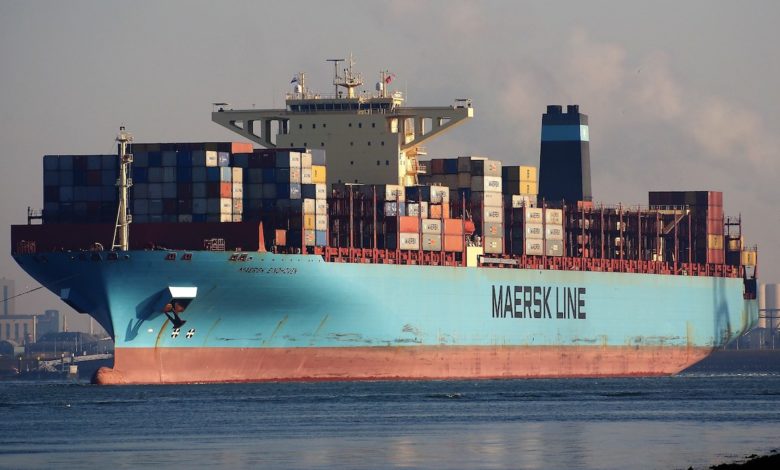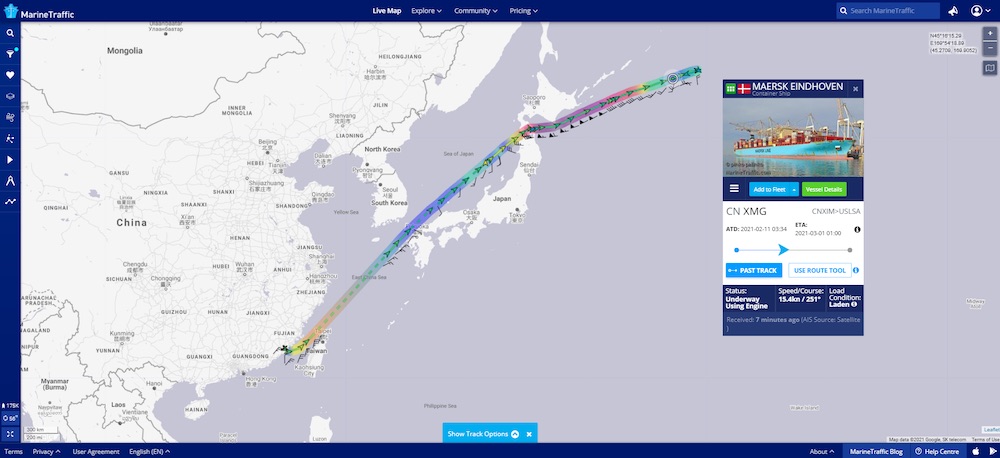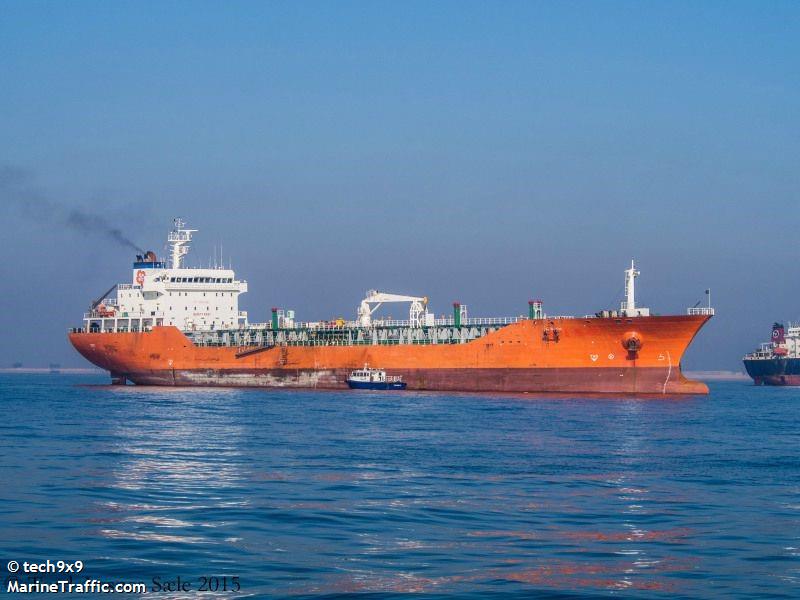Another Maersk ship loses hundreds of boxes overboard in the Pacific

The 13,100 teu Maersk Eindhoven became the latest boxship casualty on the Pacific yesterday, suffering a blackout while en route to California and a subsequent loss of hundreds of containers overboard. The accident happened near Japan as the 11-year-old ship made its way from Xiamen in China to Los Angeles. The crew are safe, propulsion has been restored and vessel tracking suggests the ship has turned around and is making for an Asian port.
Mediterranean Shipping Co (MSC), which is a vessel partner with Maersk, stated on its site that because of the engine stop in heavy weather, the Maersk Eindhoven had lost “several hundred” containers overboard – the sixth reported incident of boxes lost at sea since November 30.
Last month around 750 boxes fell off the Maersk Essen, a sister ship to the Maersk Eindhoven, both built at Hyundai Heavy Industries, also while sailing from Xiamen to Los Angeles. That ship diverted to Mexico and the Port of Lazaro Cardenas and is now tentatively set to weigh anchor in two days’ time and make for Los Angeles.
A video of the Maersk Essen coming to dock in Mexico last month is carried below.
Vessel tracking provided by MarineTraffic today (see below the video) shows the heavy weather the Maersk Eindhoven encountered on Wednesday.


 became the latest boxship casualty on the Pacific yesterday, suffering a blackout while en route to California and a subsequent loss of hundreds of containers overboard. The accident happened near Japan as the 11-year-old ship made its way from Xiamen in China to Los Angeles. The crew are safe, propulsion has been restored and vessel tracking suggests the ship has turned around and is making for an Asian port.
became the latest boxship casualty on the Pacific yesterday, suffering a blackout while en route to California and a subsequent loss of hundreds of containers overboard. The accident happened near Japan as the 11-year-old ship made its way from Xiamen in China to Los Angeles. The crew are safe, propulsion has been restored and vessel tracking suggests the ship has turned around and is making for an Asian port.
Bridge team has to pay attention on effects of Parametric Rolling. Must take action well in time to avoid it. Ship owners should stop building mega container ships
Not agree. There is more factors but always is easier to say crew should do something to avoid losses and so on. What about following:
1. Owners shall follow this what vessel was designed for, not increasing on existing vessels deck stack weight by 25% or increasing draft (both to take more and more cargo) and in same time cancelling requisition for lashing materials…
2. How sure are we that loaded boxes are exactly mathing to this what is on stability software? It is enough to swap 1 heavy unit from bottom tier to top and LF are significantly above max allowed.
3. During docking – almost nobody is checking and repairing containers fundation or lash eyes as being to expensive and finaly it is delegating to crew who can max de-rust and paint (but without checking the steel thickness).
4. Delivering good quality and accurate weather data – i. e. real wind in 90% situation is about 150% higher than SPOS data…
5. Unwritten office pressure to arrive on time and maintain the schedule, consuming as less fuel as possible.
So just saying “Bridge team has to pay attention on effects of Parametric Rolling” is worth nothing… I assumed it was said by office guy who saw the ship on the calendar. Best regards.
Excellent comment Bro.
100%
Why there is no CRY about pollution??? Sometimes it is enough to drop overboard a basket of food waste to get a million fine or get prosecuted and here hundreds of containers go overboard with frightening regularity and nobody gives a ship about it!
Those mega container monsters undoubtedly heading to mega-disaster one day.
Can not control any rolling if me is kaput.
The shipowners, operators and designers of this type of ships and their lashing systems will have to change their mentality, so as not to continue putting the lives of the crews at risk, effectively fight against any type of pollution and end the game with insurance for large economic losses
i think we should ask why vessel was planning such bad passage? did Master check the passage, the weather forecast before crossing Tsugaru Strait? shortest passage is not always the safe one!
And so what are Maersk doing about recovering these container’s which are beginning to litter the sea bed; and what pollution might be leaking from them too!
Guess they’ll just choose to forget about them knowing Maersk!!
Two sister ships involved in similar accident may not be a mere coincidence but may point to a greater malaise. This needs to be probed.
“Mariners have always understood the concept of the ‘one-in-seven’ wave. In reality they should also be conscious that the 1/1000 wave (that’s probably around 2 to 3 times a day) there will be one combined wave which is almost twice the size of the backgrounded sea/swell. So this vessel might well have experience 16m !!! sea/swell conditions during this period. Mariners and route planners beware. The rhumb may well be the preferred route.” One in Seven – Beware!
See https://youtu.be/7yuw1MqyVOs for a reconstruction of the voyage and wave conditions on Feb 16 and 17 2021.
Excellent comment Sir.
Allow me pls to chip in from very reliable sources , what confirms Your above statement/remark.
Significant wave height
Marine weather forecasts usually provide information on wind velocity (speed and
direction) and wave height. The usual term to define wave height is ‘significant
wave height’, abbreviated as HS.
This is the average of the highest one-third (33 per cent) of waves, measured from trough to
crest, that occur during a given period.
Significant wave height is therefore an average of the largest waves and this does mean that individual waves may be higher. Significant wave height is actually a statistical term and indicative of a certain range of wave heights.
This is best explained on the basis of a graph showing the wave numbers on the vertical axis and wave height on the horizontal axis.
REM:
Pls see the graph in Gard Guidance on Freight Containers available on line . Chapter: Navigation and Ship handling or in other available in the web sources as it seems I can not due to unknown reasons post web links in comments section.
END OF REM
As can be seen in the above graph, there are a relatively high number of small waves
(left side of graph) and a low number of very large waves (right side of graph).
This implies that you will not encounter a significant wave very frequently. However,
statistically, it is possible to encounter a wave that is much higher than the significant wave.
For example, given that HS is 10 m,
statistically this implies that:
H (mean) = (0.64) Hs = 6.4 m
H (most probable) = 6.0 m
H1/10 (10% highest waves) = (1.27) Hs = 12.7 m or higher
H1/100 (1% highest waves) = (1.67) Hs = 16.7 m or higher
H 1/1000 (0.1% highest waves) = (1.86 Hs) = 18.6 m or higher
The Canadian National Marine Weather Guide provides information on the
likelihood of meeting a particular wave height within a given time frame:
highest wave likely over a 10 – minute period 1.6 x Hs
highest likely wave over a 3 – hour period 2.35 x Hs
highest likely wave over a 12 – hour period 2.25 x Hs
highest likely wave over a 24 – hour period 2.35 x Hs
The energy generated by a wave is proportional to the square of its height.
For example, a 30 m high wave will hit the vessel with a force equivalent to four times
that of a 15 m wave.
Following extensive research on this subject, it has been recognised that containerships are sensitive to certain ship motions and hydrodynamic effects, such as:
» excessive rolling, i.e. beyond the design criteria
» slamming (bow and stern)
» hydro elastic effects (springing and whipping).
CHEERS
‘One in Seven’ – Beware!
“Mariners have always understood the concept of the ‘one-in-seven’ wave. In reality they should also be conscious that 1/1000 (that’s probably around 2 to 3 times a day) there will be one combined wave which is almost twice the size of the backgrounded sea/swell. After analyzing weather and seastates (see Maersk Eindhoven analysis on youtube) this vessel may well have experienced 16m sea/swell conditions during this period. Mariners and route planners beware! The rhumb may well be the preferred route.”
Is it possible that the lowest container Tier 82 is not enough strong to support all the weight above resting on it, when vertical accelerations occur during storm? If the container vertical corner pylon corrupt there is no lashing that can hold the entire stack and bay load. All the containers are certified, but the whether and time make no mercy. Biger ship, more tiers, more load over lower tier container. I am sure that owners know the true reason, but is not safe for their business to public it.